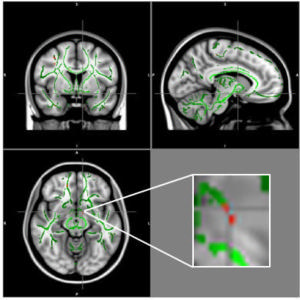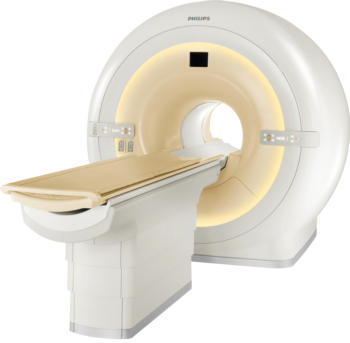Brain’s Appetite Regulator Disrupted in Obese Teens
Released: November 30, 2017
At A Glance
- Obese teenagers have disrupted white matter integrity in several regions of the brain.
- The affected brain regions are associated with appetite, emotions, impulse control, and reward and pleasure in eating.
- Obesity among adolescents has more than quadrupled over the past three decades.
- RSNA Media Relations
1-630-590-7762
media@rsna.org - Maureen Morley
1-630-590-7754
mmorley@rsna.org - Linda Brooks
1-630-590-7738
lbrooks@rsna.org
CHICAGO – Researchers using advanced MRI to study obese adolescents found disrupted connectivity in the complex regions of the brain involved in regulating appetite, according to a new study presented today at the annual meeting of the Radiological Society of North America (RSNA).
According to the Centers for Disease Control and Prevention (CDC), obesity has more than quadrupled in adolescents over the past 30 years. It is estimated that more than one-third of children and adolescents in the U.S. are overweight or obese. Obesity in adolescence is associated with a number of health risks, including cardiovascular disease and diabetes.
The study at the University of Sao Paulo in Brazil included 59 obese adolescents between the ages of 11 and 18 and 61 healthy control adolescents matched for gender, age, socio-economical classification and education level. The adolescents were classified by the World Health Organization criterion for obesity. They had no other known chronic diseases or conditions. The study participants underwent diffusion tensor imaging (DTI) of the brain to evaluate white matter integrity.
DTI is a type of MRI exam that measures functional anisotropy (FA), the microscopic motion, or anisotropy, of water molecules within and surrounding the brain’s white matter fibers. Low FA values indicate greater disruption within the white matter.
“DTI is a relatively new MRI technique not widely used in clinical diagnosis,” said study author Pamela Bertolazzi, a biomedical scientist and Ph.D. student in the neuroimaging laboratory at the University of Sao Paulo.
The results showed loss of white matter integrity in several brain regions in the obese patients. Compared to the healthy controls, the brains of the obese adolescents showed a decrease in FA values in areas of the brain including the amygdala, hippocampus, thalamus, cingulate gyrus, fornix, insula, putamen, orbital gyrus and bilateral hypothalamus. Several of these regions are involved in appetite regulation, impulse control, emotions and reward and pleasure in eating.
“The data reveal a pattern of involvement among brain regions that are important in the control of appetite and emotions,” Bertolazzi said. “There was no region of higher FA in obese patients compared to the control group,” she added.
The researchers hope that these findings will offer new tools to combat this global public health crisis.
“Childhood obesity has increased 10 to 40 percent in the last 10 years in most countries,” Bertolazzi said. “If we are able to identify the brain changes associated with obesity, this DTI technique could be used to help prevent obesity and avoid the complications associated with the condition.”
Co-authors are Prof. Fabio Duran, Ph.D., Naomi Costa, Prof. Cristiane Kochi, Ph.D., Prof. Marilia Seelaender, Ph.D., Thaysa Neves, Ph.D., Elie Calfat, Ph.D., and Prof. Ricardo Riyoiti Uchida, Ph.D.
Note: Copies of RSNA 2017 news releases and electronic images will be available online at RSNA.org/press17 beginning Monday, Nov. 27.
RSNA is an association of over 54,000 radiologists, radiation oncologists, medical physicists and related scientists, promoting excellence in patient care and health care delivery through education, research and technologic innovation. The Society is based in Oak Brook, Ill. (RSNA.org)
Editor’s note: The data in these releases may differ from those in the published abstract and those actually presented at the meeting, as researchers continue to update their data right up until the meeting. To ensure you are using the most up-to-date information, please call the RSNA Newsroom at 1-312-791-6610.
For patient-friendly information on brain MRI, visit RadiologyInfo.org.
Video clips (.mp4 format)

Video 1. Pamela Bertolazzi discusses the findings of her research on appetite regulator disruptions in obese teens.
Download.mp4
(Right-click and Save As)

Video 2. Dr. Pamela Bertolazzi explains why she wanted to conduct this research.
Download.mp4
(Right-click and Save As)

Video 3. Dr. Pamela Bertolazzi discussing the most surprising finding of her research.
Download.mp4
(Right-click and Save As)

Video 4. Dr. Pamela Bertolazzi discusses why her research is important.
Download.mp4
(Right-click and Save As)

Video 5. Dr. Pamela Bertolazzi shares her advice to parents of children or teenagers who are overweight or obese. E
Download.mp4
(Right-click and Save As)
Images (.JPG and .TIF format)

Figure 1. Reduction of functional anisotropy (FA) in obese patients compared to control group (clusters in red), and FA skeleton (green), superimposed on the mean of FA images in the sample. At the intersection of the alignment vectors (coordinates x, y, z: -9, 1, -12), a cluster of FA decrease located in the left hypothalamus (PFWE = < 0.05).
High-res (TIF) version
(Right-click and Save As)

Figure 2. 3 Tesla Achieva MRI scanner (Philips Healthcare).
High-res (TIF) version
(Right-click and Save As)
